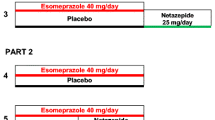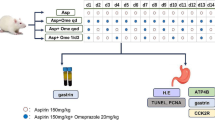Abstract
Omeprazole effectively suppresses acid secretion, resulting in the long-term elevation of intragastric pH and serum gastrin level. Pirenzepine has been reported to inhibit gastrin secretion. This study was carried out to examine the effects of additional pirenzepine treatment on the hypergastrinemia and gastric acid suppression induced by omeprazole. Concentrations of serum gastrin and plasma somatostatin were measured in 28 peptic ulcer patients before treatment, after omeprazole treatment (20 mg/day) for 2 weeks, and after omeprazole and pirenzepine (100 mg/day) treatment for 2 weeks. The acid inhibitory effect of pirenzepine treatment in addition to omeprazole was evaluated by 24-h intragastric pH measurement in six healthy volunteers. Serum gastrin level was increased significantly, to 2.4-fold the pretreatment level, by omeprazole treatment. Additional treatment with pirenzepine suppressed serum gastrin level to 0.6-fold the omeprazole-treatment level. The serum somatostatin level was not altered significantly either by omeprazole treatment or by omeprazole and pirenzepine treatment. In healthy volunteers whose pH 3 holding time on 24-h intragastric pH monitoring was 70% by omeprazole treatment, omeprazole and pirenzepine treatment markedly increased the pH 3 holding time, to 89%. These findings suggest that pirenzepine is useful in reducing the undesirable effects of omeprazole-induced hypergastrinemia, i.e., the excessive trophic effect of omeprazole on the acid-secreting part of the stomach and the overstimulation of acid secretion. The additional pirenzepine treatment is also effective in suppressing acid secretion.
Similar content being viewed by others
References
Blum AL. Treatment of acid-related disorders with gastric acid inhibitors: The state of the art. Digestion 1990;47(Suppl 1):3–10.
Walsh JH, Richardson CT, Fordtran JS. pH Dependence of acid secretion and gastrin release in normal and ulcer subjects. J Clin Invest 1975;55:462–468.
Lind T, Cederberg C, Forssell H, et al. Relationship between reduction of gastric acid secretion and plasma gastrin concentration during omeprazole treatment. Scand J Gastroenterol 1988;23:1259–1266.
Wilkes JM, Scott D, Hersey SJ, et al. Cholinergic stimulation of rabbit parietal cells is mediated by a M3 receptor. Gastroenterology 1990;98:532.
Negulescu PA, Reenstra WW, Machen TE. Intracellular Ca requirements for stimulus-secretion coupling in parietal cells. Am J Physiol 1989;256:C241-C251.
Matsuo Y, Seki A. Actions of pirenzepine dihydrochloride (LS-519 Cl) on gastric juice secretion, gastric motility and experimental gastric ulcer. Drug Res 1979;29:1028–1035.
Sue R, Toomey ML, Todisco A, et al. Pirenzepine-sensitive muscarinic receptors regulate gastric somatostatin and gastrin. Am J Physiol 1985;248:G184-G187.
Sumii K, Fukushima T, Hirata K, et al. Antral gastrin and somatostatin concentration in peptic ulcer patients. Peptides 1981;2(Suppl 2):281–283.
Walsh JH. Role of gastrin as a trophic hormone. Digestion 1990;47(Suppl 1):11–16.
Ekman L, Hanssone E, Havu N, et al. Toxicological studies on omeprazole. Scand J Gastroenterol 1985;20(Suppl 108):53–69.
Cadiot G, Lehy T, Ruszniewski P, et al. Gastric endocrine cell evolution in patients with Zollinger-Ellison syndrome. Dig Dis Sci 1993;38:1307–1317.
Rao SSC, Nayak KS, Swarnalata G, et al. Gastric carscinoid associated with ranitidine in a patient with renal failure. Am J Gastroenterol 1993;88:1273–1274.
Watson SA, Durrant LG, Morris DL. Growth-promoting action of gastrin on human colonic and gastric tumour cells cultured in vitro. Br J Surg 1988;75:342–345.
Tari A, Wu SV, Sumii M et al. Regulation of rat gastric H+/K+-ATPase α-subunit mRNA by omeprazole. Biochim Biophys Acta 1991;1129:49–56.
Karasawa H, Tani N, Miwa T. The effect of omeprazole on ultrastructure changes in gastric parietal cells. Gastroenterol Jpn 1988;23:1–8.
Karam SM, Forte JG. Inhibiting gastric H+-K+-ATPase activity by omeprazole promotes degradation and production of parietalcells. Am J Physiol 1994;266:G745-G758.
Tari A, Yamamoto G, Sumii G, et al. Role of histamine(2) receptor in increased expression of rat gastric H+/K+-ATPase α-subunit induced by omeprazole. Am J Physiol 1993;265:G752-G758.
Tari A, Hamada M, Fukino Y, et al. Effects of pirenzepine on gastrin gene expression induced by omeprazole treatment in rats. World Congress of Gastroenterology (10th Congress of Gastroenterology) Abstracts 1994;II:1992P.
Author information
Authors and Affiliations
Rights and permissions
About this article
Cite this article
Tari, A., Hamada, M., Kamiyasu, T. et al. Effects of pirenzepine on omeprazole-induced hypergastrinemia and acid suppression in peptic ulcer patients. J Gastroenterol 31, 167–170 (1996). https://doi.org/10.1007/BF02389513
Received:
Accepted:
Issue Date:
DOI: https://doi.org/10.1007/BF02389513




